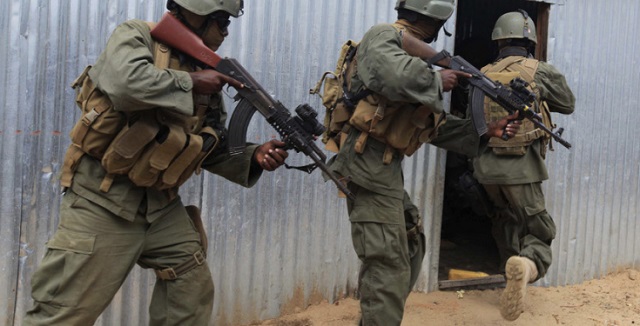
Post-COVID threats
Voronkov’s report says that outside of active conflict zones, such as the DR Congo, Somalia, or Mozambique, the spread of the COVID-19 pandemic has suppressed terrorist activity as it imposes imitations on the ability of operatives to travel, meet, fundraise and identify viable targets.
It warns, however, that as pandemic-related restrictions gradually ease, there is an elevated threat of terror attacks by ISIL and its affiliates outside conflict zones by lone actors or small groups that have been radicalised, incited and possibly directed remotely online.
“Lockdowns in many areas were more comprehensive in early 2021 than in 2020, and it is conceivable that attacks have been planned for when restrictions ease at those locations,” it says.
The report says, the terror threat is widening and evolving as it becomes more digital driven during the COVID-19 pandemic. It says there a growing potential for new and emerging technologies to be used for terrorist purposes.
“Cybersecurity needs a robust reboot to face the next iteration of digitally enabled terrorism,” the experts say, “International cooperation, effective governance in line with international law and innovative partnerships with the private sector and civil society will be decisive considerations to prevent and counter terrorism in the digital era.”
To address the increased risks, especially among young people, of exposure to online content inciting hatred or violence, UNDP provided support on the use of technology to identify hate speech content, and assisting the authorities to adopt targeted and human rights-compliant responses to the risk.
The report says terrorist groups have taken advantage of the disruption, grievances and development setbacks caused by the unprecedented global crisis, both online and on the ground.
The UN has powerful counter-terrorism architecture, largely set up in the wake of the 9/11 attack in the U.S., that helps member states implement effective frameworks to prevent, address, investigate and prosecute acts of terrorism.
The UN is also ramping up efforts to help countries adapt to the rapidly changing nature of the threat, which has become more digital and de-centralized in recent years.
Uganda was among UN member states that benefited from virtual missions conducted by the UN Counter-Terrorism Committee Executive Directorate. It also conducted virtual missions to Botswana, Ghana, and SADC countries.
Experts from counter-terrorism centres in Belgium, Colombia, Norway, the Russian Federation and Spain, as well as the European Union Agency for Law Enforcement Cooperation and the Norwegian Centre for Human Rights, delivered lectures to programme beneficiaries.
It was all part of virtual study visits organised by the global Programme on National-level Interagency Coordination Mechanisms (commonly known as “Fusion Cells”) of the Office of Counter-Terrorism.
In Nigeria, UNODC and the Executive Directorate trained law enforcement officers in the application of international best practices regarding intelligence collection and analysis.
As a result, the UN Counter-Terrorism Centre has been conducting virtual table-top and virtual reality exercises and training on countering clandestine chemical and biological threats.
The multi-agency UN Countering Terrorist Travel Programme led by the Office of Counter-Terrorism continued to assist the implementation by member states of advance passenger information and passenger name record systems. This has been done for Djibouti, Mongolia, Sierra Leone, the Gambia, South Africa and other member states of the Southern African Development Community (SADC).
Some countries have been assisted to modernise their border infrastructure by equipping them with Migration Information and Data Analysis System for identity verification and biometric collection.
The UN Counter-Terrorism Centre and its partners continued, through outreach and capacity-building activities, to support member states in preventing terrorists from acquiring both conventional and non-conventional weapons.
Noting that the world is currently witnessing a rapidly evolving situation in Afghanistan “which could have far-reaching implications” around the globe, Voronkov cited Islamic State’s expanded presence in that country and pointed out that several members of the Taliban have been designated as terrorists by the Security Council.
The Taliban and the Islamic State, whose ranks of foreigners are primarily populated by Pakistanis and a sprinkling of Central Asians, Uighurs, Russians, Turks, Iranians, Indonesians, Indians, and Frenchmen, have long been adversarial. The Islamic State recently accused the Taliban of being more nationalist than pious in their negotiations with the United States.
In what has been interpreted as a message to the world that the Taliban were cracking down on foreign jihadists and militants in Afghanistan, the Taliban unceremoniously plucked the head of the Islamic State in South Asia, Abu Omar Khorasani, from Kabul’s Pul-i-Charkhi prison where he had been detained by the previous government and shot him dead. He became the first and only person to have been executed after the Taliban gained full control of Afghanistan.
Alongside ISIL’s expansion in Africa and its rapid shift online, Voronkov also cited the continued detention of thousands of individuals with alleged links to terrorist groups as another factor exacerbating the threat.
Deteriorating conditions in detention facilities and displacement camps in northeast Syria, in particular, are serving as a rallying cry for terrorist activities. They have already fuelled instances of terrorist radicalisation, fund-raising, arms smuggling, training and incitement to terror.
Against that backdrop, he echoed calls from officials across the UN for Member States to voluntarily repatriate all concerned individuals, with a particular focus on children.
****
 The Independent Uganda: You get the Truth we Pay the Price
The Independent Uganda: You get the Truth we Pay the Price



